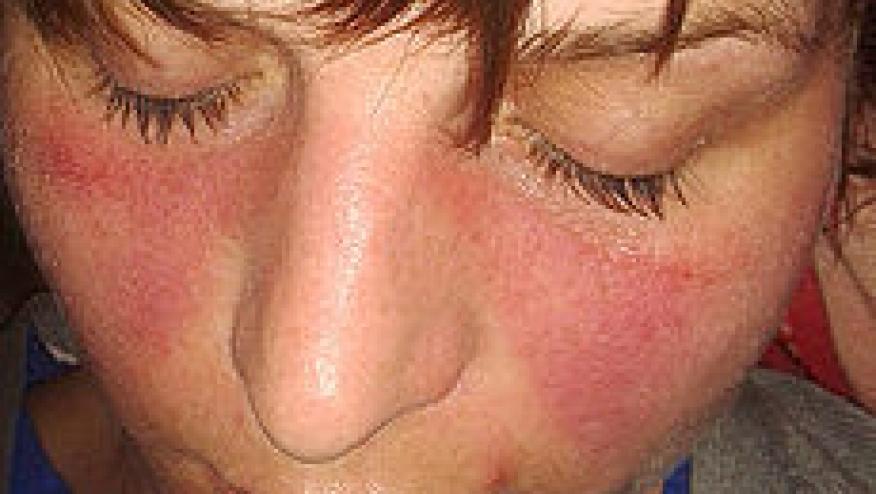TLR Antagonist in Lupus Save

An investigational Toll-like receptor (TLR) antagonist was effective in reducing biomarkers and clinical symptoms of systemic lupus erythematosus (SLE) in a pilot trial, evidence that the innate immune system may hold the key to lupus pathophysiology.
Twelve weeks of treatment with a bivalent agent called E6742 that targets TLR-7 and TLR-8 led to improvements in British Isles Lupus Assessment Group-based Composite Lupus Assessment (BICLA) responses in 57.1% of patients receiving 200 mg twice daily, compared with 33.3% of a placebo group, according to Yoshiya Tanaka, MD, PhD, of the University of Occupational and Environmental Health in Fukuoka, Japan, and colleagues.
"E6742 also had therapeutic effects on other symptoms, including skin inflammation, arthritis, and levels of anti-double-stranded DNA antibodies and complements," the group wrote in a manuscript posted to the medRxiv preprint server on Friday. (Preprints on medRxiv and similar services have not been peer-reviewed and thus must be read with caution.)
Most current lupus treatments are either broad-spectrum immunosuppressants (e.g., methotrexate and corticosteroids) or else they target the adaptive immune system, particularly those components involved in autoantibody production. The latter is true of drugs such as belimumab (Benlysta) as well as hydroxychloroquine and other antimalarials. The quasi-exception is anifrolumab (Saphnelo), approved in 2021, which antagonizes interferon receptors. Interferon release is triggered by the innate system, which then activates adaptive systems.
TLRs mediate innate immunity by recognizing molecules associated with infectious pathogens. These can be lipopolysaccharides, proteins, or nucleic acid sequences unique to these organisms. Their activation then prompts responses from the adaptive system.
By targeting these receptors directly, Tanaka and colleagues hoped to shut down lupus pathology at the earliest point in the process, preventing interferon release and the subsequent autoimmune activity. In particular, they explained, "[g]rowing evidence has demonstrated that dual inhibition of TLR7/8 may have stronger effects than inhibition of either receptor alone in the treatment of SLE, modulating innate immune responses and suppressing the production of many inflammatory cytokines, including [interferon-alpha]."
The researchers conducted a placebo-controlled phase I/II study in 26 patients, with nine randomized to placebo and 17 to either 100 or 200 mg of E6742 twice daily for 12 weeks. Like most early-stage studies, the primary outcomes involved pharmacokinetic, biomarker, and safety parameters. However, clinical effects including BICLA responses and changes in other symptom assessments were also recorded.
Patients needed to have a confirmed diagnosis of active SLE with disease duration of at least 6 months, with stable symptoms with or without conventional treatment. Most patients were taking antimalarials and corticosteroids, and nearly half were on immunosuppressants. These were allowed to continue during the trial. Recent use of targeted therapies such as belimumab or Janus kinase inhibitors, however, barred participation.
Mean patient age was about 38 and some 90% were women. Disease duration averaged about 7 years. At baseline, SLE Disease Activity Index-2000 (SLEDAI-2K) scores averaged 7.7; Cutaneous Lupus Erythematosus Disease Area and Severity Index (CLASI) scores averaged 3.6.
Overall, Tanaka and colleagues found no reason to stop development of E6742. Pharmacokinetic results were acceptable. Although nearly 80% of patients assigned to the higher drug dose developed treatment-emergent adverse events, none reached grade 3 or higher, and such events occurred in six of the nine members of the placebo group. Most adverse events were in the category of upper respiratory infections and symptoms. One serious event, classed as grade 2, occurred in the 200-mg group: a patient was hospitalized with pneumonia but recovered within a week.
Biomarker effects were generally those the researchers had hoped for. Ex vivo treatment of participants' blood samples with E6742 following application of a TLR-7/8 agonist led to rapid reductions in interferon expression and release of various downstream cytokines such as interleukin species and tumor necrosis factor.
The 100-mg dose did not appear very effective clinically. Only 37.5% of this group showed positive BICLA responses, not significantly different from the 33% rate with placebo. Other clinical assessments also showed little effect.
Treatment with the 200-mg dose, on the other hand, led to numerically greater symptom improvements for most measures than were seen with placebo. (Tanaka and colleagues did not report P values, presumably because of the small patient sample size.)
CLASI activity scores decreased by an average of 2.4 points with the 200-mg dose, versus 1.3 points in the placebo group. Similarly, tender joint counts declined by a mean 5.3 with the high dose, compared with a 0.9-point decrease with placebo. And Physicians' Global Assessment score decreases were modestly greater with E6742, at both doses, relative to placebo.
However, decreases in SLEDAI-2K scores were similar at 2.2-2.3 points with the higher drug dose and placebo.
Tanaka and colleagues were especially pleased with the drug's prevention of interferon expression. This effect, they wrote, "warrants the aggressive evaluation of E6742 efficacy in additional patient populations with more active disease and diverse clinical phenotypes, which may substantiate its potential to improve disease flares and reduce glucocorticoids."







If you are a health practitioner, you may Login/Register to comment.
Due to the nature of these comment forums, only health practitioners are allowed to comment at this time.